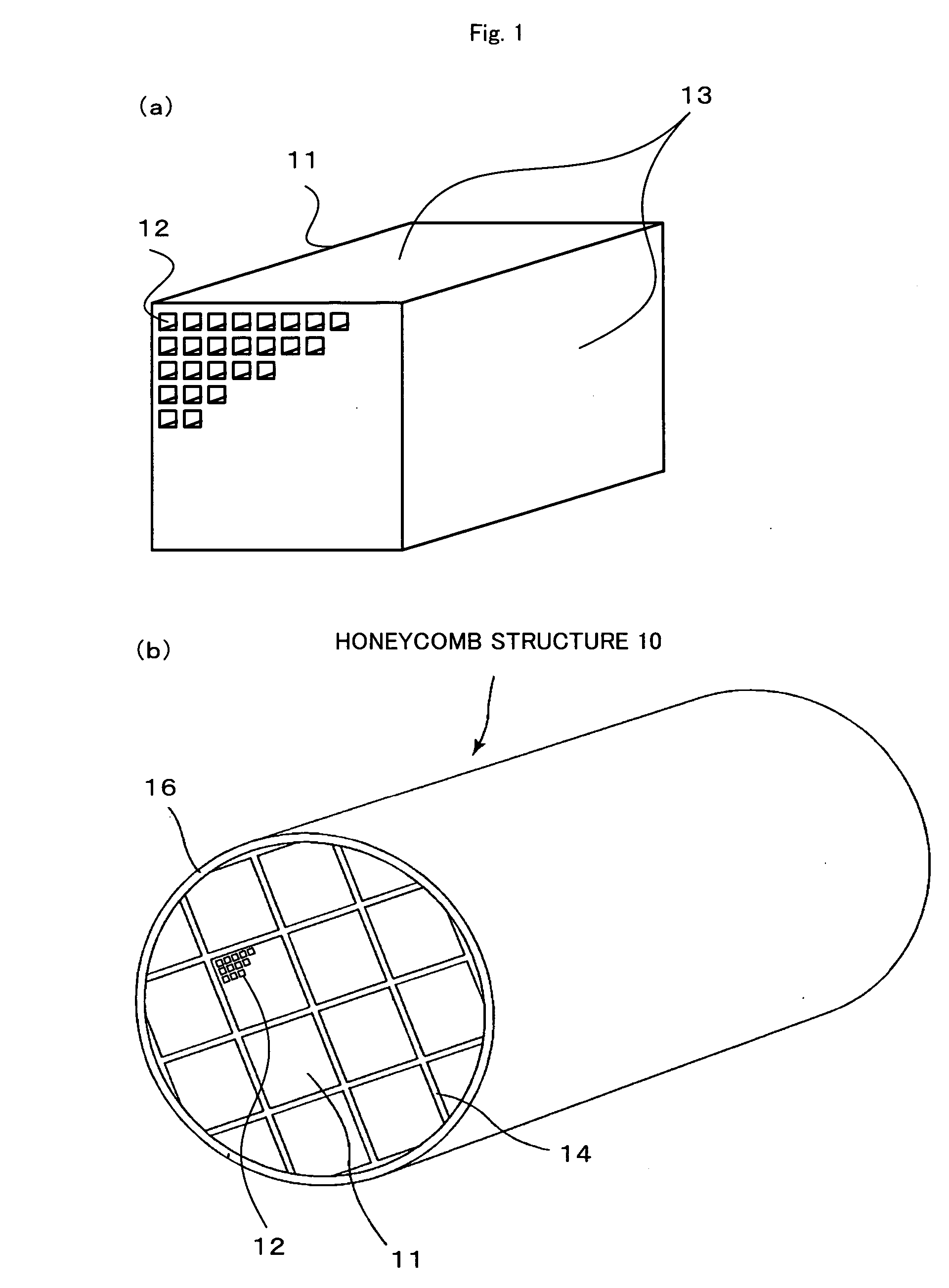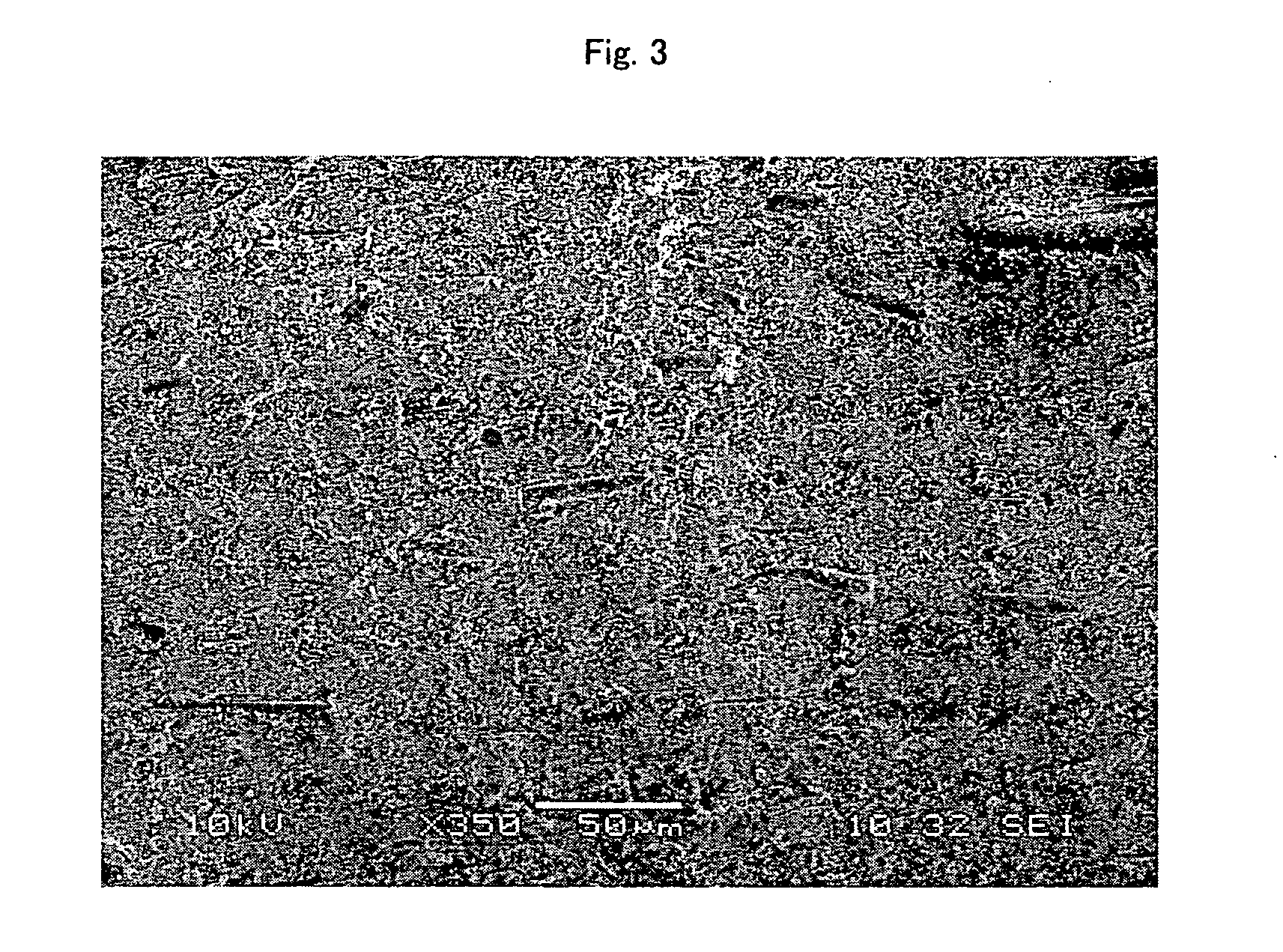Honeycomb structure
a honeycomb and structure technology, applied in the direction of metal/metal-oxide/metal-hydroxide catalysts, machines/engines, chemical/physical processes, etc., can solve the problems of increased alumina layer thickness, increased contact probability, and increased pressure loss, so as to improve the strength against thermal shock and the effect of highly dispersed catalyst components
- Summary
- Abstract
- Description
- Claims
- Application Information
AI Technical Summary
Benefits of technology
Problems solved by technology
Method used
Image
Examples
example 1
[0072] The procedure mixed 40% weight of γ-alumina particles (the averaged particle diameter of 2 μm), 10% by weight of silica-alumina fibers (averaged fiber diameter of 10 μm, averaged fiber length of 100 μm, and aspect ratio of 10), and 50% by weight of silica sol (solid concentration of 30% by weight). The process added 6 parts by weight of methyl cellulose as an organic binder, small amounts of a plasticizer and a lubricant to 100 parts by weight of the obtained mixture, then mixed and kneaded the whole mixed composition. The mixed composition was extrusion molded by an extruder to a raw molded object.
[0073] The raw molded object was sufficiently dried with a microwave dryer and a hot-air dryer, and kept at 400° C. for 2 hours for degreasing. The degreased molded object was sintered at 800° C. for 2 hours to give a porous honeycomb unit 11 of a square pillar (34.3 mm×34.3 mm×150 mm), which has cell density of 93 cells / cm2 (600 cpsi), wall thickness of 0.2 mm, and cell shape of ...
examples 2 to 7
[0076] Honeycomb structures 10 were prepared in the same manner as Example 1, except that the porous honecomb units were designed to have the shape shown in the table of FIG. 4, The shapes of the jointed object of Examples 2, 3, and 4 are respectively illustrated in FIGS. 7 (b), (c), and (d), and the shapes of the jointed object of Examples 5, 6, and 7 are respectively illustrated in FIGS. 8 (a), (b), and (c). In Example 7, since the honeycomb structure 10 was molded as an integral body, the jointing process and cutting process were not performed.
examples 8 to 14
[0077] Porous honeycomb units 11 were prepared in the same manner as Example 1, except that titania particles (averaged particle diameter of 2 μm) were used as the ceramic particle of the inorganic material of the first form and that the porous honeycomb units were designed to have the shape shown in the table of FIG. 4. Subsequently, honeycomb structures 10 were prepared in the same manner as Example 1, except that titania particles (averaged particle diameter of 2 μm) were used as the ceramic particles of the sealing material layer and the coating material layer. Note that the shapes of the jointed objects of Examples 8 to 11 are respectively the same as those shown in FIGS. 7 (a) to (d), and the shapes of the jointed objects of Examples 12 to 14 are respectively the same as those shown in FIGS. 8(a) to (c). The honeycomb structure of Example 14 was molded as an integral body.
PUM
| Property | Measurement | Unit |
|---|---|---|
| cross-sectional area | aaaaa | aaaaa |
| aspect ratio | aaaaa | aaaaa |
| cross-sectional area | aaaaa | aaaaa |
Abstract
Description
Claims
Application Information
 Login to View More
Login to View More - R&D
- Intellectual Property
- Life Sciences
- Materials
- Tech Scout
- Unparalleled Data Quality
- Higher Quality Content
- 60% Fewer Hallucinations
Browse by: Latest US Patents, China's latest patents, Technical Efficacy Thesaurus, Application Domain, Technology Topic, Popular Technical Reports.
© 2025 PatSnap. All rights reserved.Legal|Privacy policy|Modern Slavery Act Transparency Statement|Sitemap|About US| Contact US: help@patsnap.com



